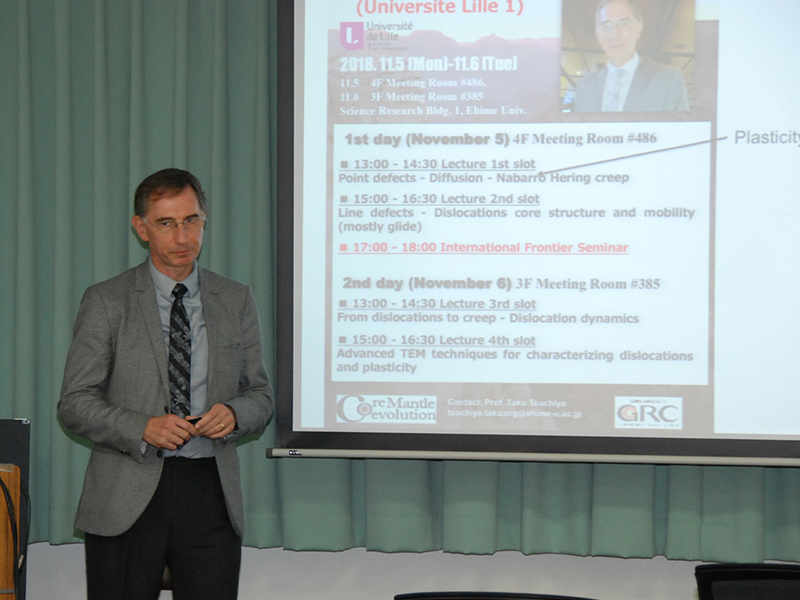2018年11月5・4日に、愛媛大学においてPatrick Cordier教授(リール第1大学)による国際セミナー・レクチャーを開催しました。

愛媛大学の学生・研究員をはじめ、東京大学・東北大学の学生など約15名が参加し、熱心に聞き入ったり、質問する姿が見受けられました。

MEXT Shin-Gakujutsu “Core-Mantle Coevolution” International Lecture
| Date | 2018年11月5日(月)6日(火) |
| Venue | 愛媛大学理学部 総合研究棟I (11/5) 4F #486 共通会議室 (11/6) 3F 共通ゼミ室 |
| Lecturer | Prof. Patrick Cordier (Universite Lille 1) |
| Title | Rheology of Deep Earth Materials <地球深部物質のレオロジー特性> |
| Schedule |
Nov.5th 13:00 – 14:30 Lecture 1st slot Point defects – Diffusion – Nabarro Hering creep 15:00 – 16:30 Lecture 2nd slot Line defects – Dislocations core structure and mobility (mostly glide) Nov.6th 13:00 – 14:30 Lecture 3rd slot From dislocations to creep – Dislocation dynamics 15:00 – 16:30 Lecture 4th slot Advanced TEM techniques for characterizing dislocations and plasticity |
The 19th MEXT Shin-Gakujutsu “Core-Mantle Coevolution”
International Frontier Seminar
| Date/Time | 2018年11月5日(月)17:00 – 18:00 |
| Venue | 愛媛大学理学部 総合研究等I 4F #486 |
| Lecturer | Prof. Patrick Cordier (Universite Lille 1) |
| Title | On the role of dislocation climb for the convection of planetary interiors |
| Abstract |
Planetary interiors are characterized by high confining pressures. Evacuating heat by convection needs activation of creep mechanisms which are efficient enough under high pressures and small deviatoric stresses. In case of a silicate like bridgmanite, dislocation modeling demonstrates that glide is strongly inhibited by pressure. Standard dislocation creep mechanisms are thus inefficients. Since diffusion is also slower under high pressure, activation of diffusion creep places very strong constraints on grain sizes which are questionnable. In this presentation, we discuss an alternative where plastic strain is produced by pure climb creep. Dislocations in climb configurations act as sources and sinks of point defects which are exchanged between (at least) two dislocation families. The resulting rheology is non linear (stress exponent 3), but it does not produce crystal preferred orientations which is in agreement with the absence of strong seismic anisotropy in the lower mantle. |






